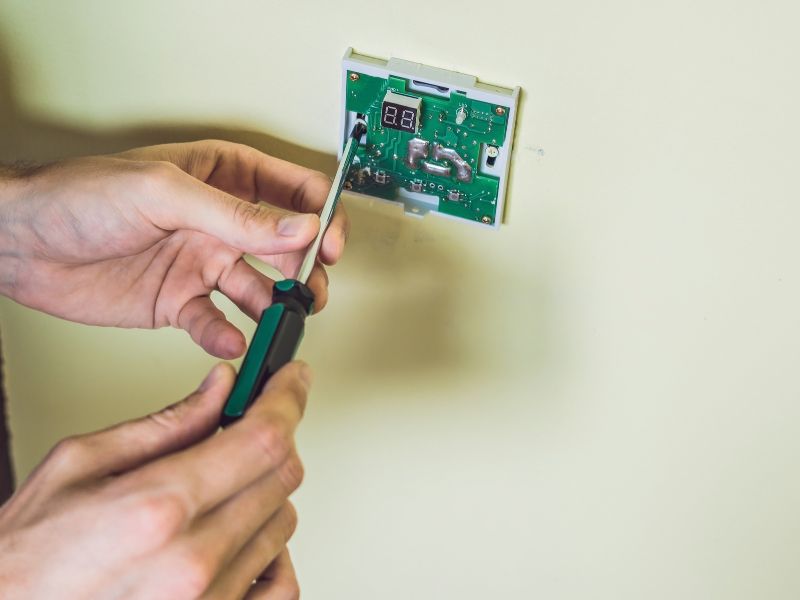Have you ever wondered if it’s worth replacing a thermostat in your home? At some point, you may have noticed that your thermostat isn’t working as it should, causing uneven temperatures and higher energy bills. Before handing over your hard-earned money to replace it, it’s important to know the benefits and drawbacks of doing so. In this article, we’ll explore the factors to consider before deciding whether or not it’s worth it to replace your thermostat. So, grab a cup of coffee and let’s dive in!
Tabe of Contents
1. Signs That Your Thermostat Needs Replacing
The thermostat is an essential component of your HVAC system that regulates your home’s temperature and indoor air quality. However, like any other electronic device, thermostats can wear out over time and may require replacement. Here are some :
- Your home’s temperature is inconsistent: If you notice temperature variations in different parts of your home or some rooms are too cold or too hot, it may indicate a malfunctioning thermostat.
- Frequent breakdowns: If your HVAC system frequently stops working or you continuously need to reset the thermostat to maintain the desired temperature, it may indicate a defective thermostat.
- High energy bills: If your energy bills suddenly increase despite using the same amount of energy, your thermostat may be the culprit. A malfunctioning thermostat can cause your HVAC system to work harder, resulting in high energy consumption.
- Outdated technology: If your thermostat is outdated and lacks modern features like programmable settings and Wi-Fi compatibility, replacing it with a new one can enhance your comfort and energy efficiency level.
If you notice any of these signs, it’s likely that your thermostat needs replacement. Upgrading to a new and advanced model can resolve these issues and improve your home’s overall indoor environment. However, before making any decisions, it’s essential to weigh the pros and cons of replacing your thermostat.
2. The Pros and Cons of Replacing Your Thermostat
Is it worth it to replace your thermostat? This is a question that many homeowners have asked themselves. While there are benefits to replacing your thermostat, there are also some downsides to consider. Here are some pros and cons of replacing your thermostat:
Pros:
- Increased energy efficiency: One of the main benefits of replacing your thermostat is increased energy efficiency. A new thermostat can help regulate your home’s temperature better, leading to lower energy bills and a smaller carbon footprint.
- More control over your HVAC system: Older thermostats may not provide as much control over your HVAC system as newer models. A new thermostat can offer features like programmable settings, remote access, and the ability to control multiple zones, giving you more control over your home’s climate.
- Better accuracy: Over time, thermostats can become less accurate, leading to inconsistent temperatures throughout your home. A new thermostat can provide more accurate temperature readings, leading to a more comfortable and consistent indoor climate.
Cons:
- Cost: One of the biggest downsides of replacing your thermostat is the cost. A new thermostat can range in price from $50 to $200 or more, depending on the features you want. Factor in installation costs if you are not comfortable with DIY installation.
- Compatibility: Not all thermostats are compatible with all HVAC systems. Before you purchase a new thermostat, make sure it will work with your system. Otherwise, you may need to upgrade your HVAC system as well.
Ultimately, whether replacing your thermostat is worth it depends on your individual circumstances. Take some time to consider the pros and cons and determine if the benefits outweigh the costs. If you have an older thermostat that’s no longer functioning properly or if you’re looking for more control over your HVAC system, then replacing your thermostat could be a smart investment.
3. Energy Efficiency Benefits of a New Thermostat
Upgrading to a new thermostat is not just about convenience and aesthetics, it also has a significant impact on your energy efficiency. Here are a few ways a new thermostat can help reduce your energy consumption, save money on utility bills, and lower your carbon footprint:
1. Accurate Temperature Control
Older thermostats often lack precision, making it difficult to maintain a consistent temperature in your home. A modern thermostat with advanced features like auto-scheduling, precise temperature sensing, and intuitive user interfaces can help you keep your home’s temperature within a comfortable range without the wasteful over- or under-heating that can happen with a faulty thermostat.
2. Zoning and Multistage Heating/Cooling
One of the most significant advantages of upgrading to a new thermostat is the ability to control different areas or zones in your home separately. With advanced models, you can divide your home into zones, each with its thermostat settings. This feature is excellent for large homes, or areas that are seldom used, as it saves energy by reducing the heating or cooling in those areas. Additionally, some models support multistage heating and cooling, allowing you to choose different temperature profiles for different times of the day.
3. Smart and Wi-Fi-Enabled Thermostats
Smart and Wi-Fi-enabled models are designed to learn your home’s heating and cooling patterns over time, enabling them to make adjustments automatically. These models are built with advanced algorithms that analyze data like your local weather forecast, outdoor humidity, and indoor temperature to make accurate heating and cooling adjustments. This function ensures that your HVAC system operates most efficiently, reducing your energy waste and creating an energy-friendly home.
In summary, the potential energy savings from a new thermostat can be significant, making it a wise investment for any homeowner who wants to make the most of their HVAC system.
4. Factors to Consider Before Replacing Your Thermostat
Before making the decision to replace your thermostat, it is essential to carefully consider a few key factors. Doing so will help you determine whether or not this investment is worth it and ensure that you choose the right type of thermostat for your home.
Budget
One of the most important factors to consider is your budget. Depending on the type of thermostat you choose to replace your current one, the cost can vary significantly. Programmable thermostats are typically more expensive than manual ones. However, the upfront cost may be worth it in the long run due to energy efficiency benefits.
Compatibility
Another crucial factor to consider is whether or not the new thermostat is compatible with your current HVAC system. Some systems require a specific type of thermostat, and purchasing the wrong one could lead to significant complications and additional costs.
Installation
Before replacing your thermostat, it is important to understand whether or not you can install it yourself or if a professional installer is required. If you are not comfortable with DIY installation, it is essential to factor in the additional costs associated with hiring a professional.
By considering these factors, you can make an informed decision about whether or not to replace your thermostat. This investment can provide significant energy efficiency benefits and lead to long-term cost savings, but it is important to choose the right type and ensure compatibility with your system.
5. How to Choose the Right Thermostat for Your Home
Choosing the right thermostat for your home is crucial in maintaining optimum comfort and energy efficiency. Here are some factors to consider before making a decision:
Compatibility
Check if the thermostat you’re eyeing is compatible with your heating and cooling system. Some thermostats are specifically made for central heating and cooling systems, while others are designed for single-zone or multi-zone systems. It’s also worth noting that some HVAC units require specific types of thermostats or have wiring that’s incompatible with certain models, so consult with a professional if you’re unsure.
Features
Thermostats come with various features that cater to different lifestyles and preferences. Some have programmable settings, allowing you to set different temperatures for different times of the day. Others have Wi-Fi connectivity, enabling you to control the temperature remotely using your smartphone or voice assistant. Consider which features you’ll actually use and which ones are just unnecessary frills.
Budget
Thermostat prices range from as low as $20 to as high as $500. Determine how much you can afford and choose a model that fits within your budget. Remember that a more expensive thermostat doesn’t necessarily equate to better performance or energy savings, so evaluate if the cost is justified by the features and benefits.
Size and Design
Thermostats come in different sizes and designs, so consider how it’ll look on your wall and if it’ll fit in the space where your old thermostat was. Some people prefer sleek and minimalist designs, while others like ones with large, easy-to-read displays. It’s also worth considering if the buttons and controls are user-friendly and accessible.
By taking into account compatibility, features, budget, and size and design, you’ll be able to choose a thermostat that’s best suited for your home and HVAC system. Keep in mind that consulting with a professional HVAC technician can provide valuable insights and recommendations.
People Also Ask
What are the signs that a thermostat needs to be replaced?
Signs that a thermostat needs to be replaced include inconsistent temperatures, a faulty display, or if the thermostat doesn’t turn on or off when it’s supposed to. If you have an older thermostat, it’s recommended that you replace it with a newer, more efficient one.
How much does it cost to replace a thermostat?
The cost to replace a thermostat can vary depending on a few factors, such as the type of thermostat, the brand, and the complexity of the installation. On average, homeowners can expect to pay anywhere from $50 to $400 for a thermostat replacement.
What are the benefits of replacing a thermostat?
Replacing a thermostat can offer several benefits, including energy savings, improved comfort, and increased control over your home’s temperature. With a newer and more advanced thermostat, you can also have access to features like remote control via mobile app or voice control.
Can I replace a thermostat myself?
It is possible to replace a thermostat yourself, but it’s important to understand that it can be a complicated process, especially if you’re not familiar with electrical work. It’s recommended that you consult with a professional HVAC technician to ensure that the installation is done correctly and safely.
What type of thermostat should I replace my old one with?
There are several types of thermostats available on the market, including programmable, smart, and Wi-Fi-enabled thermostats. When replacing an old thermostat, it’s best to consider your lifestyle, budget, and heating and cooling needs to determine which type would be best suited for your home.
Conclusion
Replacing a thermostat can be worth it if you’re experiencing issues with your current one or looking to improve your home’s energy efficiency. However, it’s important to consider the cost and benefits before making a decision. It’s recommended that you consult with a professional HVAC technician for advice on the best type and brand of thermostat for your home.

Senior HVAC Technician
With over 15 years in the HVAC industry, Lucas specializes in diagnosing intricate AC system issues. His commitment to precision and thoroughness ensures every repair restores optimal functionality to your cooling systems.

